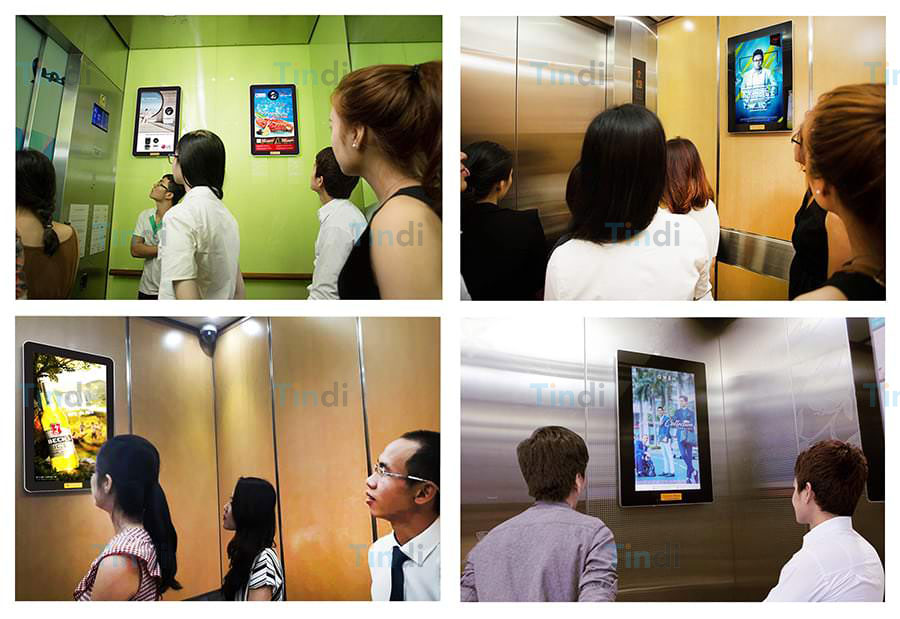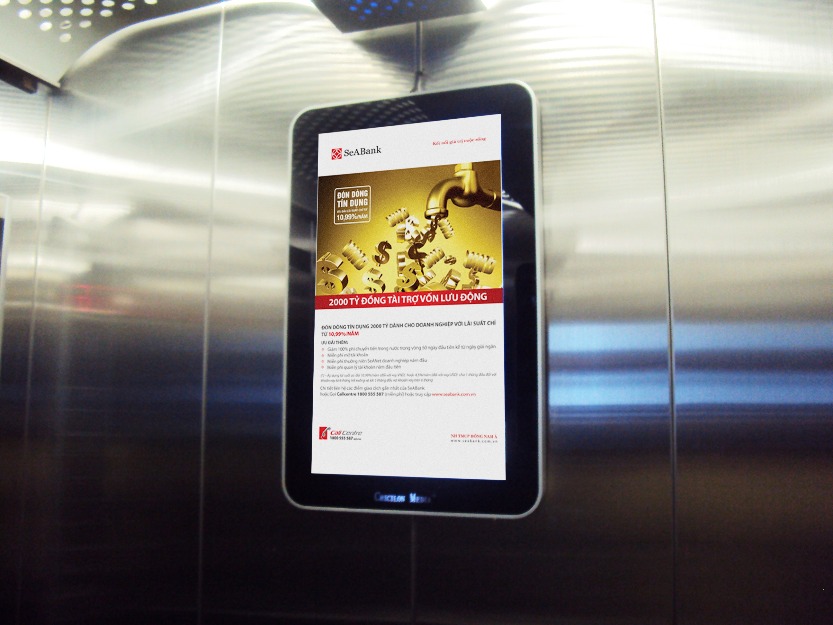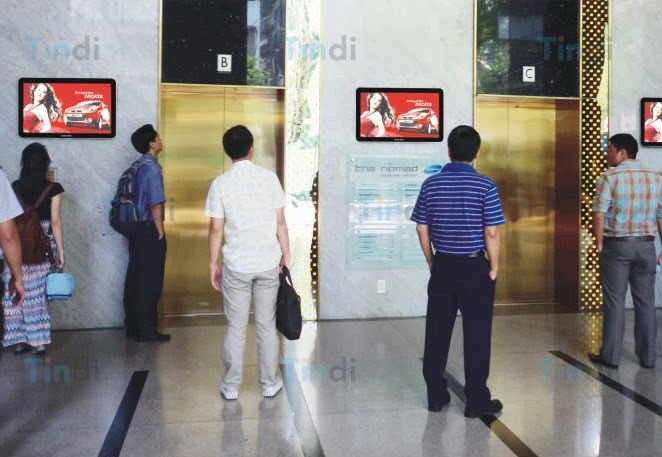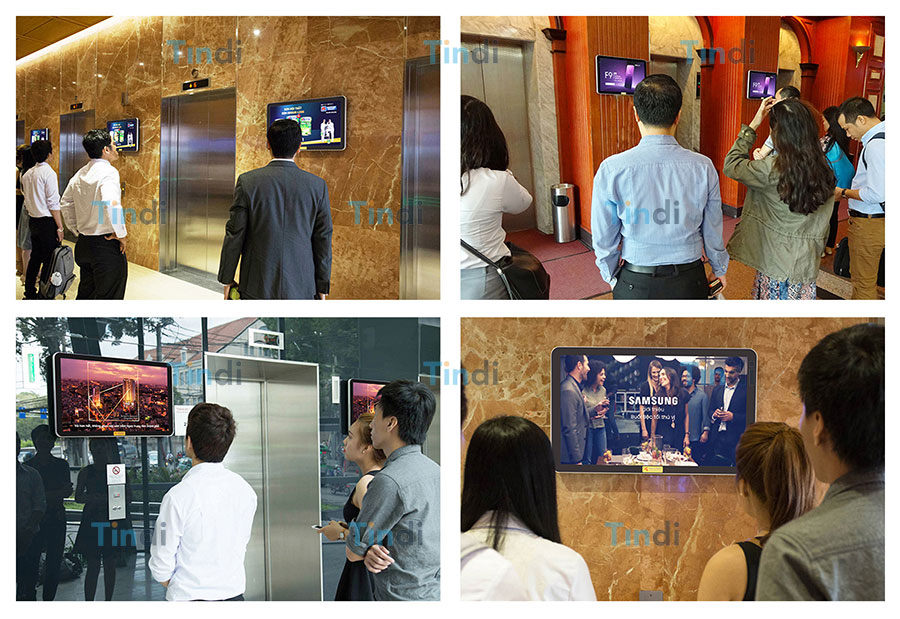LCD and Frame Advertising (Elevator Advertising) can be simply understood as advertisements displayed on screens inside or outside elevators in high-rise buildings (including office buildings, skyscrapers, apartments, shopping centers…).
This is an indoor advertising format similar to television advertising, but it appears right in front of customers as they step out of their homes, fundamentally still classified as outdoor advertising.
This advertising format first emerged in 2007 in two major cities: Hanoi and Ho Chi Minh City. With rapid and strong growth, this type of advertising has now appeared in many provinces across the country, becoming so widespread that wherever there is a high-rise building, you can be sure to find LCD and Frame advertisements.
Elevator advertising is considered a highly effective communication channel for businesses in the digital age. With advantages in displaying images and messages in a creative and eye-catching manner, it attracts customer attention and increases brand recognition, thereby boosting sales revenue.
1. What is LCD and Frame elevator advertising?
LCD and Frame advertising involves displaying images/TVC advertisements on digital screens installed inside or in the lobby of elevators in buildings.
Each building has a certain foot traffic, with an average person using the elevator about 3 to 4 times a day. In office buildings, the screens are typically on for 12 hours a day (from 7 AM to 7 PM). For apartment buildings, this may be longer (from 7 AM to 9 PM). With continuous exposure every day and advertising campaigns lasting about a month or more at this frequency, it can be sufficient for brand recall over a certain period.

Hanoi and Ho Chi Minh City are the two cities with the highest concentration of high-rise buildings, featuring thousands of apartments, office complexes, and shopping centers. Da Nang also has several dozen high-rises, while some provinces such as Quang Ninh, Hai Phong, Phu Tho… display LCD or Frame advertisements in shopping centers, supermarkets…
Learn more about advertising quote in elevators
2. How are Frame and LCD elevator advertising different?
Elevator advertising is divided into two formats: Frame and LCD. Although both display images or videos of the brand on digital screens, they differ in presentation methods, pricing, and offer various advantages and disadvantages.
2.1. Frame advertising in elevators
Frame refers to digital screens that display advertisements in the form of images. Frames are typically placed inside the elevator cabin, with each elevator having 1 to 2 Frame units. The display time is 12 seconds per frame. During this 12 seconds, advertisers can show 1 to 2 images as desired. You may also encounter other terms such as Poster Frame (PF) and Digital Frame (DP), which are categorized under Frame advertising.
Frame Screen Sizes: The most common sizes for Frame screens are 19 inches (480x318mm) and 22 inches (530x350mm). Among these, the 22-inch size is more frequently used because, when oriented vertically, it serves as a Frame, while when rotated horizontally, it becomes an LCD.

+ Advantages: A large number of Frames. Usually placed inside elevators, they are more likely to attract attention. The images are impressive and eye-catching, making them easy to remember.
+ Disadvantages: There is no dynamic sound like in TVC advertisements.
Learn more about Frame advertising quote in elevators
2.2. LCD advertising in elevators
LCD screens display advertisements in the form of TVCs lasting 15 to 30 seconds. TVC advertisements can also be replaced by slideshows of images. LCD screens are installed both inside and outside the elevator, but they are typically located in the waiting area on the first floor.

If the LCD is installed in the elevator, it’s important for customers to book both screens, as the characteristic of LCDs is to emit sound. If they do not run simultaneously, each screen may display different videos with varying audio, which can be unpleasant for people in the elevator, not to mention distracting for customers’ attention.
LCD Size: 22 inches (530x350mm) is the most common size, while there is also a larger 32-inch version (780x471mm).
+ Advantages: Vivid audio-visual experience, and generally cheaper than Frames.
+ Disadvantages: The waiting area is often quite noisy, making it difficult to hear the sound of the TVC. The number of TVCs is also typically less than that of Frames.
Learn more about LCD advertising quote in elevators
3. Target audience for elevator advertising
The target audience for advertising consists of all individuals who live, work, socialize, or conduct business in the building where the advertising campaign is implemented. Interestingly, they view the advertisements either actively or passively, being “forced” to watch them without feeling discomfort. The waiting time for the elevator and the ride itself is usually very quiet, prompting people to find something to pass the time. In such a confined space, the only moving element that attracts attention is the advertising frame. They cannot turn off the screen or change the channel, making it difficult to look away.
– Apartments: Currently, the number of apartments in cities is rapidly increasing, ranging from individual apartment buildings to modern living complexes attracting a large number of residents. Depending on the type of product and service aligned with the advertiser’s goals, appropriate apartment buildings will be selected.
– Offices: Not only do these buildings accommodate employees, but each office building typically estimates around 15% of visitors for business purposes. The characteristics of office buildings include a concentration of office workers, alongside business owners, directors, deputy directors, department heads… This is a customer segment with significant purchasing needs and financial capacity

– Shopping centers: The primary purpose of visiting a shopping center is for entertainment and shopping, and LCD Frame advertising effectively targets customer psychology. For example, if a customer is unsure about what to eat for lunch and sees a poster for “Buy 1 Get 1 Free at KFC” while waiting for the elevator, they are likely to decide to go to KFC for lunch.
4. Some notes for ensuring high effectiveness of elevator advertising campaigns
– The coverage of the campaign is a crucial factor.
A building typically has more than two elevators, sometimes up to 6-8. If a business only targets one frame, the reach to customers will be quite limited. A campaign should ideally have at least 20 frames running in multiple buildings for a minimum of one month to make a brand impression.
– Choosing display frequency of posters – closely related to the budget.
Within a single frame, there will not only be one brand’s advertisement; multiple brands will take turns displaying.
The coverage and display frequency of advertisements depend heavily on the budget.
A note for businesses is that when the budget is tight, it’s better to run at a lower frequency with more frames over a longer period, rather than running a high frequency with fewer frames. Often, advertising companies will offer additional display time that benefits customers.
– Selecting the right buildings is also very important.
If your product is in the premium segment, prioritize targeting large office buildings in busy areas. For mid-range consumer products, focus on apartment complexes and offices. This selection is usually based on data provided by advertising companies, including building location, area, the number of employees…
– Poster design.
Always remember to keep the design simple and easy to understand, ideally aligning images and messages with other advertising formats (if applicable) to enhance brand recognition. However, be mindful of rearranging layouts, font styles, and even resizing to fit the smaller LCD or Frame screens.
There is a reality like this:
It can be quite challenging to consult with major clients. This is not to criticize their design, but major brands often run synchronized formats with the same poster. However, what appears on television, newspapers, or large billboards must differ from the poster in the elevator frame. Sometimes, a poster sent over will have one-third of the bottom filled with tiny text for website addresses, phone numbers, and company addresses. In reality, even customers with perfect vision cannot read that small text, and certainly, no one has the time to scrutinize and read every line.
Besides being visually appealing, poster images should be clear and concise in their messaging.
People look at advertisements not only to pass the time but also to read about new information and attractive promotions.
5. Process for implementing elevator advertising campaigns
An LCD Frame advertising campaign typically goes through the following steps:
– Step 1: Consult with the business to choose the advertising format, the number of screens, the location of the building for implementation, and the budget allocated.
– Step 2: Once an agreement is reached, both parties will proceed to sign a contract, and the business will make the first payment to the agency.
– Step 3: The advertising company will receive the images/TVC clips from the business and display them on the screens. If there are any issues with the content or image quality, immediate corrections will be made.
– Step 4: Officially launch the campaign, and the agency will send the final images and videos to the business for approval.
– Step 5: Settle the remaining contract payment.
6. Update advertising quote for elevator advertising
Unlike LED advertising screens that can be deployed at individual locations, when businesses want to book LCD Frame advertising, they must book all the screens installed in that building since they operate under a unified control system. As a result, the business’s images and videos will be synchronized and have better coverage across multiple positions.
Compared to other advertising formats, the pricing for LCD and Frame advertising is relatively affordable, making it accessible even for small and medium-sized enterprises. A minimum deployment period of one month is required, and the more screens booked, the better the pricing.
Note: The pricing for LCD Frame advertising may vary depending on current market conditions. Businesses can book in combo packages and should regularly update their pricing to receive the best discounts.



